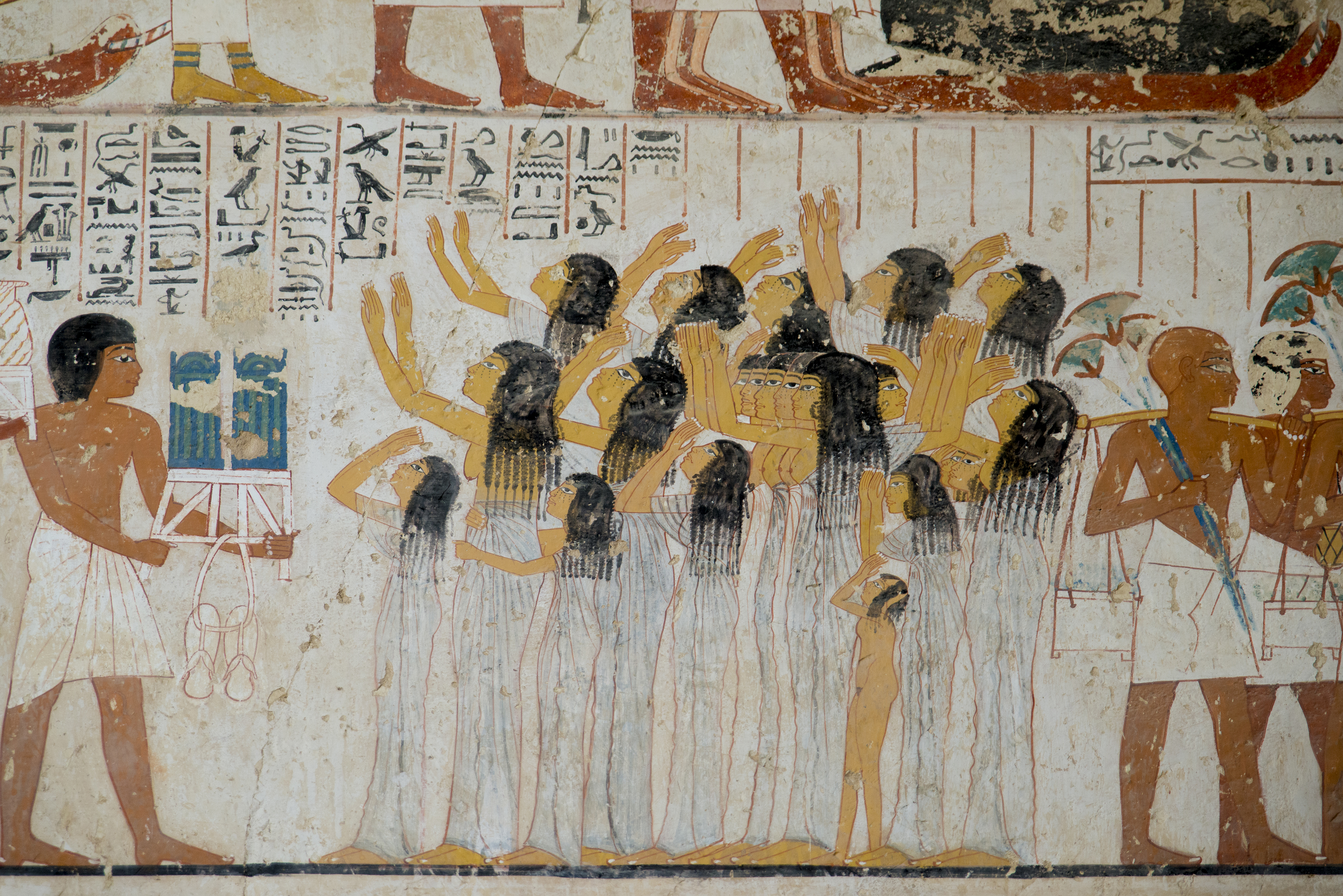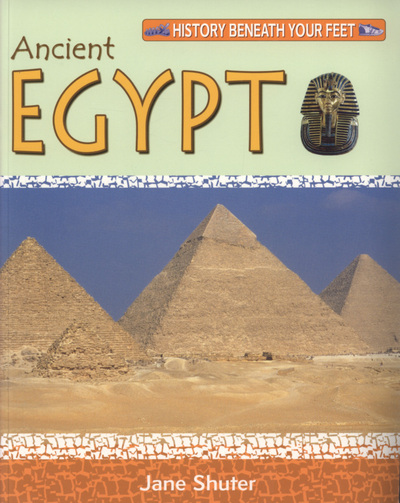



Source: Haiku Deck
Like other ancient civilisations, Ancient Egypt had a very strict class system. This system decided who held power, what kind of jobs a person could have and what kind of life they lived. Read through the resources below to learn more about the social classes of Ancient Egypt.

This model of a granary was discovered in a hidden chamber at the side of the passage leading into the rock cut tomb of the royal chief steward Meketre, who began his career under King Nebhepetre Mentuhotep II of Dynasty 11 and continued to serve successive kings into the early years of Dynasty 12.
The four corners of this model granary are peaked in a manner that is sometimes still found in southern Egypt today presumably to offer additional protection against thieves and rodents. The interior is divided into two main sections: the granary proper, where grain was stored, and an accounting area. Keeping track of grain supplies was crucial in an agricultural society, and it is noteworthy that the six men carrying sacks of grain here are outnumbered by nine men taking care of measuring and accounting. Of the four scribes two are using papyrus scrolls, two write on wooden writing boards.
Haremhab was a royal scribe and general of the army under Tutankhamun. He continued to serve during the reign of Aya and eventually succeeded Aya as king. This statue was made before Haremhab ascended the throne. By having himself depicted as a scribe, Haremhab declares himself to be among the elite group of literate individuals, thus following a tradition more than a thousand years old of depicting great officials as men of wisdom and learning.
He sits erect, but relaxed, his gaze slightly down. Across his knees he unrolls a papyrus scroll on which he has composed a hymn to the god Thoth, patron of scribes. A shell containing ink lies on his left knee. Over his left shoulder is a strap with a miniature scribe's kit attached to each end. A figure of the god Amun is incised on his forearm, perhaps indicating a tattoo.
In this statue the unlined, youthful face is belied by the potbelly and the folds of flesh beneath the breasts. These artistic conventions indicate that the subject has reached the age of wisdom. Although the scribal pose exhibits the frontal orientation common to all formal Egyptian statue, it may be appreciated more fully as a piece of sculpture in the round since it has no back pillar. The youthful face reflects the features seen on many statues depicting Tutankhamun (50.6), and the style of this magnificent life-size sculpture retains some of the softness and naturalism of the earlier Amarna period while looking forward to later Ramesside art.
This rectangular stone stela honors an official named Mentuwoser. Clasping a piece of folded linen in his left hand, he sits at his funeral banquet, ensuring that he will always receive food offerings and that his family will honor and remember him forever. To the right of Mentuwoser, his son summons his spirit. His daughter holds a lotus, and his father offers a covered dish of food and a jug that, given its shape, contained beer.
To show clearly each kind of food being offered, the sculptor arranged the images on top of the table vertically. The feast consists of round and conical loaves of bread, ribs and a hindquarter of beef, a squash, onions in a basket, a lotus blossom, and leeks. The low-relief carving is very fine. The background was cut away only about one-eighth of an inch. Within the firm, clear outlines, the sculptor then subtly modeled the muscles of Mentuwoser's arms and legs and the shape of his jaw and cheeks. The chair legs and the calf's head have also been carefully formed. The hieroglyphic inscriptions in sunk relief state that in the seventeenth year of his reign King Senwosret I presented the stela to Mentuwoser in appreciation of his loyal services. Mentuwoser's deeds are described at length. He was steward, granary official, and overseer of all manner of domestic animals, including pigs. He is described as a good man who looked after the poor and buried the dead. Senwosret's throne name, Kheperkare, appears within a cartouche in the middle of the top line.
The stela once stood at Abydos, the sacred pilgrimage center of the god of the underworld Osiris. Mentuwoser's image and the prayers on the stela were meant to bring him both rebirth and sustenance at the annual festivals honoring Osiris. At such festivals family members and other pilgrims would visit the commemorative chapels in which the stelae were set up, and at its end this stea's text addresses explicitly three groups of people: 1. any scribe who shall read the stela; 2. any person who shall hear the stela read aloud; 3. all people who shall approach it. It is thus suggested that, according to ancient Egyptian understanding, the written word—and its imagery—reached many more people than only just the fully literate.
Scarabs bearing the names of nonroyal individuals first appeared in the later Twelfth Dynasty, concurrent with other significant cultural and political developments. Thereafter scarabs were mass produced, primarily as amulets, though they often also functioned as administrative seals.
On its top ledge, this stela proclaims the name of King Nebhepetre Mentuhotep II (ca. 2051–2000 B.C.), the founder of the Middle Kingdom. In the same line, the stela's owner, Intef, refers to himself as "his (the king's) servant." Intef also recounts that he was overseer of a fortress and served in the region of Herakleopolis, the capital city of the minor kings who ruled northern Egypt before the country's reunification under Mentuhotep II. An official could only have been appointed here after Mentuhotep II eliminated the last of the Herakleopolitan rulers during his reunification of Egypt (ca. 2021 B.C.)
All of the individuals in this small group are males, represented according to the conventions of Amarna art. The intriguing group has been variously interpreted as a family comprising a grandfather, a father, and a son, or as one man at three different stages of life. The latter is most unlikely as the multiple representations of a single individual in one statue are not shown interacting as they do here. In fact careful examination of the faces and figures points to the statue's being a kind of domestic icon. The figure at left is a high-status individual and likely the oldest; he is probably a revered relative or the respected overlord of the man and boy who stand closely entwined with one another. The statuette would probably have received veneration in the household of its owner.
This model of a combined bakery and brewery was discovered in a hidden chamber at the side of the passage leading into the rock cut tomb of the royal chief steward Meketre, who began his career under King Nebhepetre Mentuhotep II of Dynasty 11 and continued to serve successive kings into the early years of Dynasty 12.
The making of bread and beer was closely related in ancient Egypt, both using basically the same kind of ingredients. The two processes are therefore combined here in one workshop complex, albeit with separate rooms. A guard with a baton sits inside the screened off main doorway that leads first into the brewery. Here a man crushes the grain with a pestle, then two women grind it into flour, which another man works into lumps of dough, possibly adding yeast from the square basin in the corner. After a second man has added water to the lumps of dough and treaded the mash with his feet in a tall vat, the resulting liquid is set aside in four tall crocks to ferment. After fermentation it is poured off into round jugs that are covered with black clay stoppers. The bakery in the inner room is divided by a screen wall into two compartments. In the first a man again crushes grain with a pestle for two female millers to grind into flour. Two men then mix the dough in tall tubs, while two black ovens are tended by a man with a poker. In the middle of it all stands a basket with baked conical loaves. In the second compartment are two more men with pestles; two others make loaves and cakes of various shapes, some of which are baked on two circular stoves, while some must have been carried over to the ovens in the first section of the room.
The scene at the top of the stela depicts Wedjashu, the daughter of Hor, worshipping Osiris, Harendotes (who is identified with Min in Akhmim), Anubis, Isis and Nephthys. The offering formula in the text names Osiris, Sokar-Osiris, Harendotes, Isis and Nephthys plus all the gods of Ipw - the ancient name of Akhmim - on behalf of Wedjashu who was a sistrum player. Her father Hor was a royal scribe, and her mother was the housemistress Ankhes.
This gives an example of the job opportunities available to people based on their parents' status.


 Ancient Egypt
Ancient Egypt
 Ancient Egypt
by
Ancient Egypt
by